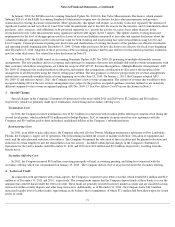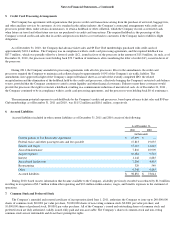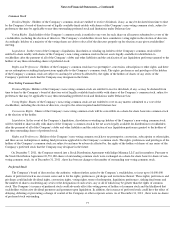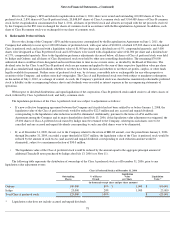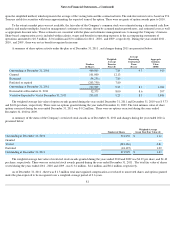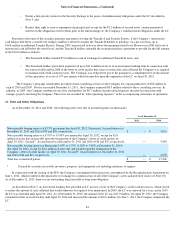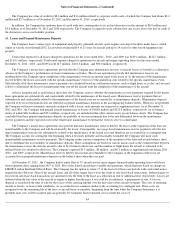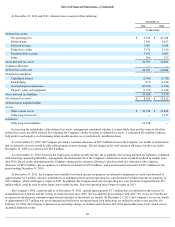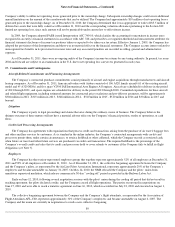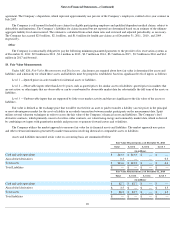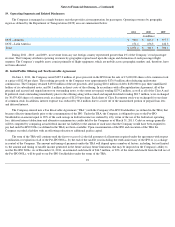Spirit Airlines 2011 Annual Report Download - page 95
Download and view the complete annual report
Please find page 95 of the 2011 Spirit Airlines annual report below. You can navigate through the pages in the report by either clicking on the pages listed below, or by using the keyword search tool below to find specific information within the annual report.
Notes to Financial Statements—(Continued)
The Company has a line of credit for $8.6 million and $3.6 million related to corporate credit cards, of which the Company had drawn
$2.4
million and $2.5 million as of December 31, 2011 and December 31, 2010 , respectively.
In addition, the Company has undrawn lines of credit with two counterparties to its jet fuel derivatives in the amount of $8.0 million and
$1.0 million as of December 31, 2011 and 2010 respectively. The Company is required to post collateral for any excess above the line of credit if
the derivatives are in a net liability position.
The Company leases various types of equipment and property, primarily aircraft, spare engines and airport facilities under leases, which
expire in various years through 2032. Lease terms are generally 6 to 12 years for aircraft and up to 24 years for other leased equipment and
property.
Total rental expense for all leases charged to operations for the years ended 2011 , 2010 , and 2009 was $139.1 million , $122.7 million ,
and $110.1 million , respectively. Total rental expense charged to operations for aircraft and engine operating leases for the years ended
December 31, 2011 , 2010 , and 2009 was $116.5 million , $101.3 million , and $90.0 million , respectively.
The Company’s master lease agreements provide that the Company pays maintenance reserves to aircraft lessors to be held as collateral in
advance of the Company’s performance of major maintenance activities. These lease agreements provide that maintenance reserves are
reimbursable to the Company upon completion of the maintenance event in an amount equal to the lesser of (1) the amount of the maintenance
reserve held by the lessor associated with the specific maintenance event or (2) the qualifying costs related to the specific maintenance event.
Substantially all of these maintenance reserve payments are calculated based on a utilization measure, such as flight hours or cycles, and are used
solely to collateralize the lessor for maintenance time run off the aircraft until the completion of the maintenance of the aircraft.
At lease inception and at each balance sheet date, the Company assesses whether the maintenance reserve payments required by the master
lease agreements are substantively and contractually related to the maintenance of the leased asset. Maintenance reserve payments that are
substantively and contractually related to the maintenance of the leased asset are accounted for as maintenance deposits. Maintenance deposits
expected to be recovered from lessors are reflected as prepaid maintenance deposits in the accompanying balance sheets. When it is not probable
the Company will recover amounts currently on deposit with a lessor, such amounts are expensed as supplemental rent. As of December 31,
2011 and 2010 , the Company had prepaid aircraft maintenance to lessors of $168.8 million and $132.0 million , respectively, on its balance
sheets of which $48.2 million and $15.1 million , respectively, are included within other current assets on our balance sheets. The Company has
concluded that these prepaid maintenance deposits are probable of recovery primarily due to the rate differential between the maintenance
reserve payments and the expected cost for the related next maintenance event that the reserves serve to collateralize.
The Company’s master lease agreements also provide that most maintenance reserves held by the lessor at the expiration of the lease are
nonrefundable to the Company and will be retained by the lessor. Consequently, any usage-based maintenance reserve payments after the last
major maintenance event are not substantively related to the maintenance of the leased asset and therefore are accounted for as contingent rent.
The Company accrues for contingent rent beginning when it becomes probable and reasonably estimable the Company will incur such
nonrefundable maintenance reserve payments. The Company makes certain assumptions at the inception of the lease and at each balance sheet
date to determine the recoverability of maintenance deposits. These assumptions are based on various factors such as the estimated time between
the maintenance events, the date the aircraft is due to be returned to the lessor, and the number of flight hours the aircraft is estimated to be
utilized before it is returned to the lessor. The Company expensed $1.5 million , $0 million , and $0.2 million as supplemental rent during 2011 ,
2010 , and 2009 , respectively. Maintenance reserves held by lessors that are refundable to the Company at the expiration of the lease are
accounted for as prepaid maintenance deposits on the balance sheet when they are paid.
At December 31, 2011 , the Company had its entire fleet of 37 aircraft and six spare engines financed under operating leases with lease
term expiration dates ranging from 2017 to 2023. Five of the leased aircraft have variable rent payments, which fluctuate based on changes in
LIBOR (London Interbank Offered Rate). The Company has the option to renew 17 of the leases for three-year periods with contractual notice
required in the 10th year. Nine of the aircraft leases and all of the engine leases were the result of sale-lease-back transactions. Deferred gains or
losses from sale-lease-back transactions are amortized over the term of the lease as a reduction in rent or additional rent, respectively. Losses are
deferred when the fair value of the aircraft or engine is higher than the price it was sold for, in substance, a prepayment of rent. A loss on
disposal is recorded at the time of sale for the excess of the carrying amount over the fair value of the aircraft or engine. The costs of returning
aircraft to lessors, or lease return conditions, are accounted for in a manner similar to the accounting for contingent rent. These costs are
recognized over the remaining life of the lease as aircraft hours accumulate, beginning from the time when the Company determines it is
probable such costs will be incurred and can generally be estimated. Such estimated costs exclude the costs of
84
13.
Leases and Prepaid Maintenance Deposits


